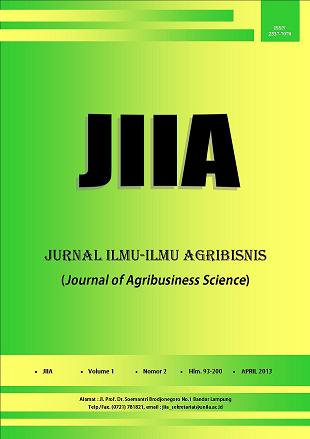ANALISIS BASIS EKONOMI SUBSEKTOR INDUSTRI PENGOLAHAN HASIL PERTANIAN DAN KEHUTANAN DI KOTA BANDAR LAMPUNG
DOI:
https://doi.org/10.23960/jiia.v1i2.243 Abstract View: 1220
Abstract View: 1220
Abstract
The purpose of this study was to analyze the role of industry sub-sectors of agriculture and forestry product processing in Bandar Lampung on the theory of the economic base. The data used were secondary data from various institutions which was analyzed by analytical tools of location quotient (LQ), and the multiplier effect. The research results showed that the manufacture as sub-sectors of agriculture and forestry in Bandar Lampung has a value of LQ > 1 in which average was 1.3654 (Base). The role of the industry sub-sectors of agriculture and forestry product processing in Bandar Lampung was in the economic base region. Any change in the average income of Rp1, the subsector of agriculture and forestry product processing could increase the total revenue of Rp5.90. The average change in total revenues in Bandar Lampung in the year of 2006-2010 amounted to Rp374,619,000,000. It is suggested that the manufacturing subsector is more developed together with the community and all policy holders in Bandar Lampung industry sub sectors, namely food, beverages, and tobacco, due to its rapid growth and competitiveness. In addition, to improve the economic could also be one of the tourist attractions in Bandar Lampung as the city's of “Tapis Berseri”.
Keywords: economic base, industrial processing of agricultural and forestry, location quotion
Downloads
Downloads
Published
How to Cite
Issue
Section
License
Authors who publish with this journal agree to the following terms:
Authors retain copyright and grant the journal right of first publication with the work simultaneously licensed under a Creative Commons Attribution License that allows others to share the work with an acknowledgement of the work's authorship and initial publication in this journal.
Authors are able to enter into separate, additional contractual arrangements for the non-exclusive distribution of the journal's published version of the work (e.g., post it to an institutional repository or publish it in a book), with an acknowledgement of its initial publication in this journal.
Authors are permitted and encouraged to post their work online (e.g., in institutional repositories or on their website) prior to and during the submission process, as it can lead to productive exchanges, as well as earlier and greater citation of published work (See The Effect of Open Access).














